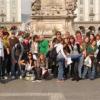St Pauls truly is the spiritual home of Great Britain, a fascinating store of British history and an architectural triumph all in one. The great dome dominates much of the city and forms the centrepiece of the reconstruction of London after the Great Fire of 1666. Built by Sir Christopher Wren after the fire, the cathedral miraculously survived the Blitz in World War Two when most of the surrounding area was flattened by German bombing raids. It consequently served to act as an inspirational symbol of British strength in the nation´s darkest hour. The formidable funerals of Lord Nelson, the Duke of Wellington and Sir Winston Churchill were conducted inside these fortress-like walls, as was the elaborate fairy-tale wedding of Prince Charles and Lady Diana Spencer. Sombre services marking the end of the First and Second World Wars, and joyous celebrations marking Queen Victoria and King George Vs Jubilees, have also filled its echoing galleries.
Globe Theatre:
Founded by the pioneering American actor and director Sam Wanamaker, Shakespeare´s Globe is a unique international resource dedicated to the exploration of Shakespeare´s work and the playhouse for which he wrote, through the connected means of performance and education.
Together, the Globe Theatre Company, Shakespeare´s Globe Exhibition and Globe Education seek to further the experience and international understanding of Shakespeare in performance.
Hyde Park: One of London´s finest historic landscapes covering 142 hectares. There is something for everyone in Hyde Park. With over 4,000 trees, a lake, a meadow, horse rides and more it is easy to forget you´re in the middle of London. Many people enjoy picnics in the parks. You can get there by tube. (Lancaster Gate & Marble Arch - Central Line or Hyde Park Corner & Knightsbridge - Piccadilly line)
Tate Modern:
Tate Modern is the national gallery of international modern art. Located in London, it is one of the family of four Tate galleries which display selections from the Tate Collection. The other three galleries are Tate Britain, also in London, Tate Liverpool, in the north-west, and Tate St Ives, in Cornwall, in the south-west. Created in the year 2000 from a disused power station in the heart of London, Tate Modern displays the national collection of international modern art. This is defined as art since 1900. International painting pre-1900 is found at the National Gallery, and sculpture at the Victoria & Albert Museum. Tate Modern includes modern British art where it contributes to the story of modern art, so major modern British artists may be found at both Tate Modern and Tate Britain.
Westminster Abbey:
Westminster Abbey is steeped in more than a thousand years of history. Benedictine monks first came to this site in the middle of the tenth century, establishing a tradition of daily worship which continues to this day. The Abbey has been the coronation church since 1066 and is the final resting place of seventeen monarchs. The present church, begun by Henry III in 1245, is one of the most important Gothic buildings in the country, with the medieval shrine of an Anglo-Saxon saint still at its heart. A treasure house of paintings, stained glass, pavements, textiles and other artefacts, Westminster Abbey is also the place where some of the most significant people in the nation´s history are buried or commemorated. Taken as a whole the tombs and memorials comprise the most significant single collection of monumental sculpture anywhere in the United Kingdom.



































































































